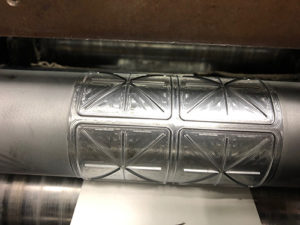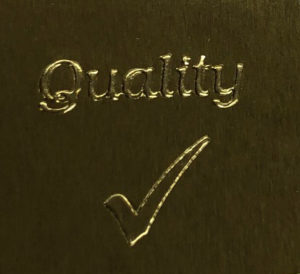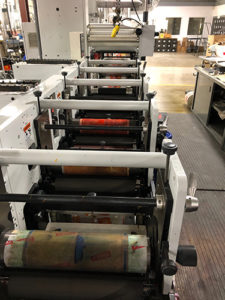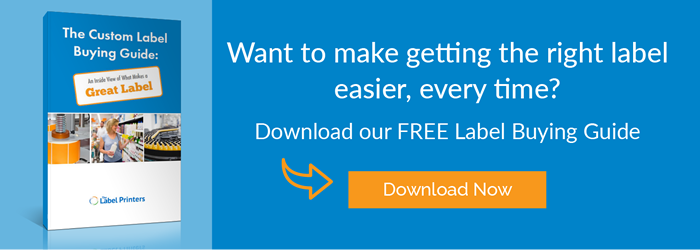Custom Label Printing: Terms and Definitions
There’s a whole universe of materials, methods, and technology available for label companies, as we create custom labels that look great, capture your brand, and endure your environmental conditions. A label printer who knows their stuff will walk you through all these possibilities with clarity and patience.
For a window into how your label printer approaches this, read on. This glossary of label printing terms will help you understand your options and explain them to the rest of your team.
A
Abrasion resistance
Also called “rub” or “scuff” resistance, this refers to the toughness of an ink or coating. Specifically, it’s the ability to resist deterioration or destruction caused by friction.
Adhesive
A substance capable of holding materials together by surface attachment.
Did You Know?
Some adhesives can lose their grip at high or low temperatures or when exposed to too much moisture. Some adhesives work well on glass, while others are better suited to porous materials, such as paper. Your label printer will help you choose the right adhesive for your product.
Application temperature
The temperature of an application surface or label material at the time the label will be applied. All adhesives have a minimum application temperature rating. Temperature can be a factor in the design of labels that will be applied in hot or cold environments.
B
Bleed
When the printed image extends beyond the trim edge of the label. This is done to avoid the appearance of outside margins in the label itself.
BOPP
BOPP, or biaxially-oriented polypropylene, is a printing surface made of polypropylene that has been stretched flat. Non-toxic and resistant to solvents and acids, it is an excellent choice for food and beverage labels.
C
Color matching
To duplicate the hue, value and intensity of a given color sample, usually by blending appropriate elements.
Tip: Your computer monitor combines red, green, and blue (RGB) light to produce different colors. The standard printing process used four inks: cyan, yellow, magenta, and black (CMYK). To ensure the most accurate color matching possible, your label printer will ask you to submit artwork in CMYK format.
Copy
Any furnished material (manuscript, pictures, artwork, etc.) to be used in the production of printing.
Crazing
The appearance of a network of small cracks in a varnish coat or a plastic face stock.
Crop marks
The marks made on the outer edges of artwork to designate where cuts are to be made for trimming, sheeting, or die cutting.
Cut Single
Cut single labels are individual labels with a paper backing that can be peeled away. This type of label is often used for giveaways to consumers.
D
Debossing
The process of impressing a design or image into (below) the label surface, adding another design element to the finished label. It often uses a set of matched rollers to create the desired effect.
Die
Cutting tool or device used for creating the desired shape of a label. Dies can be used to cut only the face material of a pressure sensitive face stock (leaving the liner untouched), to punch out shapes within a label, or to cut through the both the face stock and the liner completely to create cut single labels.
Die Cut
To cut labels with a die. Also a term used to describe labels formed by die cutting.
Tip: Your label printer can use different die cutting techniques to give your label interesting shapes and even cut “windows” into it.
Digital printing
Digital technologies imprint images directly to media without reliance on plates. This option enables printers to create labels with variable images – literally every label can be different from all the others. Digital printing also delivers crisp, high resolution images and in some cases can enable a printer to more efficiently respond to requests for smaller quantity runs.
Direct Thermal
Printing method using heat upon a specially coated substrate (printing surface). The process uses a heating element to cause an image or words to appear by selectively applying heat to areas of the surface. A coating on the surface changes color when heated.
E
Edge lift
When the edge of a label rises off the surface of the application surface. This condition occurs most frequently on small diameter curved surfaces. Resistance to edge lift is dependent on the label’s bond strength, the flexibility of the label, and the method of application. There are specific label materials and adhesives made for small diameter and curved surface applications.
Elastic memory
A tendency of some materials to attempt to return to their original length after being elongated.
Embossing
The process of raising a design or image above the label surface, adding another design element to the finished label. It often uses a set of matched rollers to create the desired effect.
Tip: Embossed and debossed textures can give your label a premium feel. It works well for luxury products such as fine wines and perfumes.
Engraving
A general term normally applied to any pattern which has been cut into a surface by hand, mechanical, or etching process.
F
Face stock
The surface in a label stock construction onto which the printed image is to be impressed. A wide variety of paper, film, fabric, and foil materials are suitable for use as pressure sensitive label face stock. In finished labels the face stock is often covered by a transparent laminate, which is applied to protect the printed image.
Face slit
A slit in the face material of a pressure sensitive label that makes it easier to remove from its backing.
Film
Face and liner material manufactured from synthetic polymers.
Tip: Film labels may hold up to moisture better than paper labels, making them a good choice for beverages and other liquids.
Finish
The surface property of a material determined by its texture and gloss. It describes surface characteristics like smoothness, gloss, absorbability and print quality.
Flexographic printing
A method of rotary printing which employs flexible plates affixed to cylinders that are inked by a roll. It also involves rotary die cutting, rapid-drying inks, in-line laminating, and other converting operations.
Did you know?
One alternative to flexographic printing is digital printing. Digital printing doesn’t use plates; it takes images directly from digital files (such as a pdf). Digital printing allows for more variation than traditional methods. Flexographic printing, however, may allow for more accurate color matching.
Flock
A commercial fuzz or lint consisting of fine strands or filaments. It is applied to an adhesive coated surface to produce a decorative felt-like appearance and texture.
Foil
A very thin metal sheet that can be used as face stock material in label production.
Tip: Consumers make buying decisions in split seconds. Metallic foils can add a touch of class to your label that will stand out on the shelf.
Four-color process
Printing with cyan, yellow, magenta, and black (CYMK) inks using screens to reproduce the wide spectrum of colors. This is referred to as process printing or CMYK printing.
Freezer adhesives
Adhesives that will function at temperatures below the freezing point. They are usually removable at room temperatures.
GHS labels
Labels that adhere to the Globally Harmonized System of Classification and Labelling of Chemicals, which is an internationally agreed-upon standard managed by the United Nations.
H
Hang tag
Also referred to as swing tag, coupon tag, hang ticket or swing ticket. These are the paperboard or plastic swinging tags that are familiar on garments and point of sale applications. Most (but not all) hang tags are free of adhesive.
Heat seal labels
Label paper that has a coating which melts under heat to form the bonding agent.
High temperature adhesive
An adhesive that enables a pressure sensitive label to adhere or stick well when applied to a hot surface. It has a high degree of resistance to aging or deterioration at high temperatures.
Hue
The main attribute of a color which distinguishes it from other colors. Red, orange, yellow, green, blue are color hues.
I
Imprinting
Technique in which copy is added to blank or previously printed labels or tags with a secondary printing device such as an imprinter, computer printer, or typewriter.
Ink
Ink is a pigment or dye dissolved or suspended in a solvent. Many inks also contain additives such as waxes, drying agents, or other substances to create desired special effects (such as with metallic inks).
Knockout
In color printing, the process of dropping an image out of the color such as dropping white type out of a color background. Often called reverse printing.
L
Label stock
Pressure-sensitive laminate material from which labels are produced. It consists of a face stock, an adhesive and a release liner. Usually refers to roll stock.
Tip: Pharmaceutical makers should be extra-conscious of the durability of their labels. Pharmaceutical labels carry critical information for patients and healthcare providers, and when they peel off, rip, or become illegible, they can imperil lives. Look for a label printer that can provide expert guidance on adhesives, materials, and application surfaces, and that employs a full-time quality control staff.
Letterpress
Printing process which employs a relief or raised inked image which comes into direct contact with the material being printed.
M
Memory
The property of a material that causes it to return to its original dimensions and shape. Memory can cause a label material to want to lift off a curved surface. Stronger adhesives or thinner gauge materials, or both, are often the solution.
Metalizing
Applying a thin coating of metal to a non-metallic surface.
Minimum application temperature
The lowest temperature at which a pressure sensitive label (adhesive) can be applied to a product and still retain its initial tack.
O
P
Padded (tablet style)
Sheets of labels that are bound together by applying flexible glue or adhesive to one edge of the stack.
Pearlescent pigments
Pearlescent pigments consist of particles, such as synthetic or real mica, that reflect light. The optical effect is one of partial reflection from the two sides of each flake. Effects range from brilliant highlighting to moderate enhancement of the normal surface gloss.
Permanency
A measure of an adhesive’s ultimate holding power or bond strength. A permanent adhesive will develop a bond that makes label removal difficult or impossible without distorting or tearing the face stock or the surface the adhesive has bonded to.
Pigment
The particles or substance that gives printing inks, dyes or paints their color.
Piggyback labels
Multi-layer constructions that have one pressure-sensitive adhesive label on top of another. Part or all of the top layer is removable and is used as a separate label, while the bottom layer stays affixed to the original surface.
Polyethylene
A tough, stretch plastic film with very good low temperature characteristics. Also used a great deal for producing semi-rigid recyclable bottles.
Polypropylene
Similar to polyethylene but stronger and having a higher temperature resistance. It is also used in various thicknesses in the printing of labels as well as backing or liner materials. Tear-proof and waterproof, they are a good choice for wet or abrasive conditions.
Tip: If you want customers to be able to remove your labels, a synthetic material such as polypropylene, combined with a moderate adhesive, may peel away easier than paper.
Pressure-sensitive label stock
The combination of face material, pressure-sensitive adhesive and release liner from which pressure sensitive labels are manufactured.
Process color
Color printing created by a color separation process, where a piece of copy is broken down into the primary colors (yellow, magenta, cyan, and black). These are then recombined at the press to produce the likeness of the original image. “Process color” has long been used as shorthand for Four Color Process, which is a more technical name for the same thing. This should not be confused with the more advanced printing process called Extended Gamut, which can generate a wider range of colors by using orange, green and violet in addition to the standard four colors.
Production run
The final printing requested by the customer from the original artwork.
Q
Did You Know?
Barcodes aren’t just for the checkout aisle. Advanced barcode technology (such as QR codes) can help you track your product and its components throughout the supply chain, cutting down on waste and gray-market sales. Barcodes can also add interactive elements to your labels, enabling buyers to use their mobile devices to learn more about your products.
R
Register marks
Symbols attached to original copy for registering two or more colors when printing.
Removable adhesive
A pressure sensitive adhesive with clean removability from a wide variety of surfaces. The adhesive on “sticky notes” is a good example of removable adhesive.
Repositionable
The ability of a pressure sensitive label to be bonded to a surface, removed and repositioned. This can only be done for a limited period of time (e.g., 20 minutes). Beyond that time, the bond may begin to become permanent if a removable adhesive wasn’t used.
Reverse printing
A design in which the copy is “dropped-out” and the background is printed making the copy appear in the color of the background. Printing on the underside of a transparent film is sometimes referred to as reverse printing, although that process also can be described as Back Printing, which can be a helpful term to use for avoiding confusion with printing an image in reverse.
Roll label
Pressure-sensitive labels that are produced in a continuous roll form.
S
Score
To make an impression or a partial cut in a material for the purpose of bending, creasing, folding, or tearing.
Self-laminating labels
Imprintable labels with a transparent flap that is affixed on top of the label once imprinted or written upon, protecting it from tampering or smudging.
Sheet form
Pressure sensitive label stock packaged in sheets and designed for used on a sheet feed press.
Solvent resistance
The resistance of a pressure sensitive label to the action of specific organic liquids. May apply to either adhesive or printing.
Did You Know?
Solvents and harsh chemicals (such as the ones used to sterilize medical equipment) are some of the significant factors that can impact the lifespan of your label. Others include light, heat, moisture, and rough handling.
Substrate
A surface onto which something is applied. In the label industry, this term is frequently used in reference to the surface to which a label is applied. More generally across the printing industry, the surface onto which an image is imprinted is referred to as a substrate. As a result, this term is used in several ways in discussions of label printing and can sometimes be the source of confusion. The term “Face Stock” provides a useful alternative term to help avoid such confusion.
Sunlight resistance
The ability of a material to resist the deteriorating effects of sunlight especially those wavelengths in the ultraviolet and the infrared ends of the spectrum.
T
Tack
The property of a pressure sensitive label which causes it to adhere to a surface instantly with a minimum of pressure and contact time. It is the feeling of stickiness obtained when the surface of an adhesive is touched or when a label is applied to a surface and quickly pulled away.
Tamper evident label
A pressure sensitive construction made of materials which will partially destruct, indicating that a package, label or container has been tampered with.
Did You Know?
Counterfeiting may cost the global economy as much as a quarter trillion dollars annually. Commonly counterfeit items include fashion products, pharmaceuticals, luxury goods, and electronics. Tamper evident labels keep buyers safe and help companies protect the integrity of their brands.
Tarnishproof label
Refers to a pressure sensitive label being free of substances that will discolor or blemish copper or silver.
Thermal transfer labels
Labels made from a face stock that is specifically designed to accept heat activated ink from the ribbon of a thermal transfer printer.
Tolerance
A specified range that products must fall within. Size and color are two common factors where tolerance comes into play.
Tip: Expect your label printer to ask you how much variation in color you can tolerate in label features such as logos. Printers talk about the differences between color shades using a measurement called delta e. Most humans can’t detect the difference between two colors with a delta e of 2.0 or less.
Tooling
Tools used to cut labels such as dies, sheeters, scoring and slitting wheels, and butt cutters.
U
UL
Underwriters Laboratories Inc. (UL) is an independent, non-profit, product-safety testing and certification organization. It has been testing products for public safety for more than a century and is one of the most recognized and reputable conformity assessment providers in the world.
Tip: The labeling requirements for electronics and electronic components can be complex, requiring an understanding of state and federal safety and environmental regulations. An expert label printer can advise you on your regulatory obligations, as well as the right label options for meeting them.
UV resistance
The ability of any material to withstand extended exposure to sunlight without degradation, hardening or excessive discoloration.
V
Variable data
Information, such as text copy or numbers, that may vary from one item to another. Serial numbers are a common example of variable data. Address labels and name badges are common label applications that integrate variable data.
Vignette
An illustration in which the background fades gradually until it blends into the unprinted area.
Weatherability
Capability of a label to withstand the effects of outdoor conditions such as sunlight, heat, cold, humidity, rain, snow and time.
Z
Zig zag fold
Labels manufactured from a continuous web of label stock and then folded into a zigzag accordion style format for packing flat in packaging.




